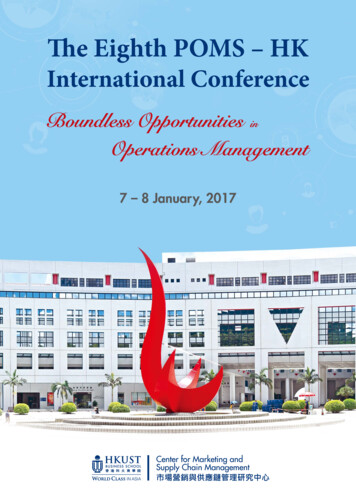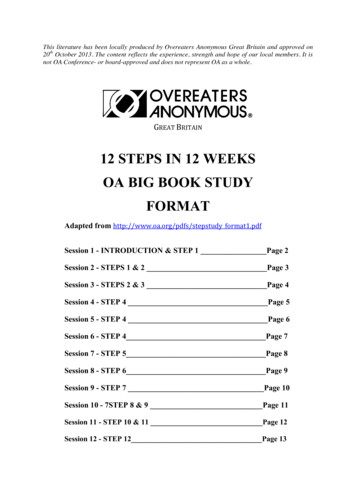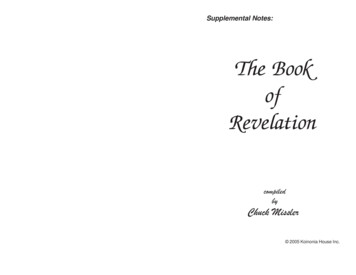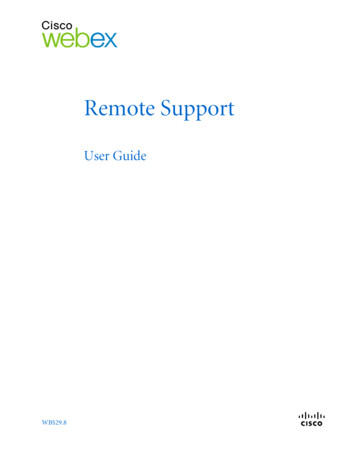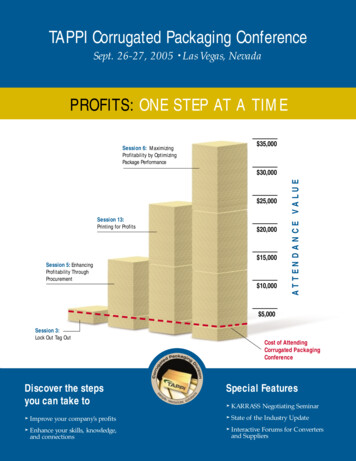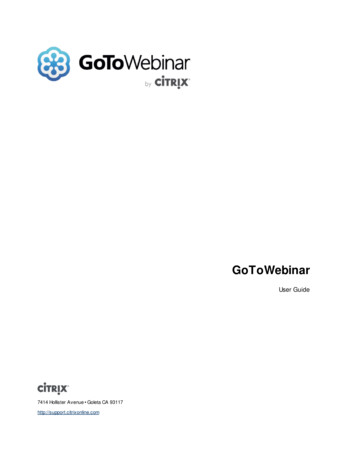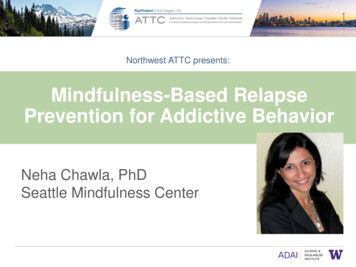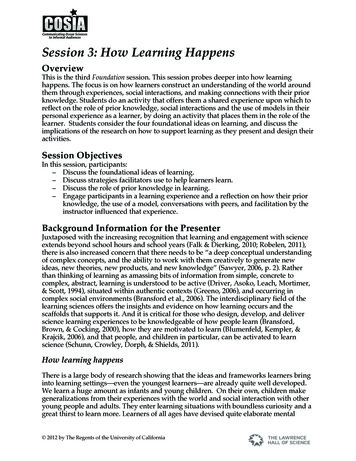
Transcription
Session 3: How Learning HappensOverviewThis is the third Foundation session. This session probes deeper into how learninghappens. The focus is on how learners construct an understanding of the world aroundthem through experiences, social interactions, and making connections with their priorknowledge. Students do an activity that offers them a shared experience upon which toreflect on the role of prior knowledge, social interactions and the use of models in theirpersonal experience as a learner, by doing an activity that places them in the role of thelearner. Students consider the four foundational ideas on learning, and discuss theimplications of the research on how to support learning as they present and design theiractivities.Session ObjectivesIn this session, participants:– Discuss the foundational ideas of learning.– Discuss strategies facilitators use to help learners learn.– Discuss the role of prior knowledge in learning.– Engage participants in a learning experience and a reflection on how their priorknowledge, the use of a model, conversations with peers, and facilitation by theinstructor influenced that experience.Background Information for the PresenterJuxtaposed with the increasing recognition that learning and engagement with scienceextends beyond school hours and school years (Falk & Dierking, 2010; Robelen, 2011),there is also increased concern that there needs to be “a deep conceptual understandingof complex concepts, and the ability to work with them creatively to generate newideas, new theories, new products, and new knowledge” (Sawyer, 2006, p. 2). Ratherthan thinking of learning as amassing bits of information from simple, concrete tocomplex, abstract, learning is understood to be active (Driver, Asoko, Leach, Mortimer,& Scott, 1994), situated within authentic contexts (Greeno, 2006), and occurring incomplex social environments (Bransford et al., 2006). The interdisciplinary field of thelearning sciences offers the insights and evidence on how learning occurs and thescaffolds that supports it. And it is critical for those who design, develop, and deliverscience learning experiences to be knowledgeable of how people learn (Bransford,Brown, & Cocking, 2000), how they are motivated to learn (Blumenfeld, Kempler, &Krajcik, 2006), and that people, and children in particular, can be activated to learnscience (Schunn, Crowley, Dorph, & Shields, 2011).How learning happensThere is a large body of research showing that the ideas and frameworks learners bringinto learning settings—even the youngest learners—are already quite well developed.We learn a huge amount as infants and young children. On their own, children makegeneralizations from their experiences with the world and social interaction with otheryoung people and adults. They enter learning situations with boundless curiosity and agreat thirst to learn more. Learners of all ages have devised quite elaborate mental 2012 by The Regents of the University of California
Session 3: How Learning Happens2frameworks to try to explain and make sense of their experiences in the world aroundthem. Although these explanations may not be fully accurate, they are often complexand evolve over time. Emerging from research on learning, there are four foundationalideas on how learning happens that are focused on in depth in this course.–––––Learning is an active process of engaging and manipulating objects, experiences,and conversations in order to construct a mental picture of the world (Dewey, 1938;Piaget, 1964; Vygotsky, 1986). Learners build knowledge as they explore the worldaround them, observe and interact with phenomena, converse and engage withothers, and make connections between new ideas and prior understandings.Learning builds on prior knowledge, and involves enriching, building on, andchanging existing understanding, where “one’s knowledge base is a scaffold thatsupports the construction of all future learning” (Alexander, 1996, p. 89).Learning occurs in a complex social environment, and thus should not be limited tobeing examined or perceived as something that happens on an individual level.Instead, it is necessary to think of learning as a social activity involving people, thethings they use, the words they speak, the cultural context they’re in, and the actionsthey take (Bransford, et al., 2006; Rogoff, 1998), and that knowledge is built bymembers in the activity (Scardamalia & Bereiter, 2006).Learning that is situated in an authentic context provides learners with theopportunity to engage with specific ideas and concepts on a need-to-know or wantto-know basis (Greeno, 2006; Kolodner, 2006).Learning complex ideas deeply involves considerable mental effort and persistence,which requires learners’ motivation and cognitive engagement to be sustained.Human knowledge is acquired through a process of active construction; concepts areinvented rather than discovered; and learners’ prior knowledge and experiences areimportant (Duit, 1995). Each of us generates our own “rules” and “mental models,”which we use to make sense of our experiences. Learning, therefore, is perceived as anactive process of engaging and manipulating objects (Piaget, 1983), experiences (Dewey,1938), and conversations (Vygotsky, 1986) to construct mental pictures of the world;and is cumulative, iterative, and social. To understand and make sense of their world,individuals transform, organize, and relate new information and experiences to those inthe past. In this way, learning is a contextualized process of making sense ofexperiences in terms of prior knowledge within social and physical contexts over time(Rennie & Johnston, 2004).Learning is a social activity, and occurs through discourse within socialinteractions (Vygotsky, 1978). The contributions of individuals and their social partnersare examined together with the social and historical customs and materials that exist inthe context as people engage in shared endeavors. This perspective requires a shift fromthinking of learning as something that happens on an individual level, to thinking oflearning as a social activity involving people, the things they use, the words they speak,and the actions they take (Rogoff, 1998). From this perspective, knowledge is coconstructed between members in the activity, and knowledgeable adults and peers playimportant roles in helping less experienced learners make meaning of new experiences.They promote learners’ curiosity and persistence, direct learners’ attention, structureexperiences, support learning attempts, and regulate the complexity and difficulty oflevels of information (Bransford, et al., 2000). It is important to remember that 2012 by The Regents of the University of California
Session 3: How Learning Happens3constructing knowledge requires intellectual support to do so. Without guidance, alearner, and children in particular, may not be able to make sense of concepts andpotentially leave an interaction with an incomplete or incorrect understanding of anidea (Grandy, 1997; King, 2009; Klahr & Nigam, 2004).Promoting better learningComplementing the foundational ideas on learning, there are four supports thatpromote better learning:– Cognitive tools are both mental and computational devices that assist constructivethinking, and may be a symbol system, mental strategy, or computer program(Jonassen, 1992; Pea, 1985; Salomon, Perkins, & Globerson, 1991) used to support,guide, and enhance the thinking processes of their users in performing conceptualoperations otherwise beyond their abilities; and can be applied to a variety of subjectmatter domains. These tools are computer-based technologies, such as makingconcept maps and data visualization.– Scaffolding is the help given to a learner that is customized to that learner’s needs inachieving his or her goals of the moment. This support stems from the idea thatexperienced individuals can help less experienced learners extend their learningbeyond where they are able to go on their own based on their physical ordevelopmental level (Vygotsky, 1978; Wood, Bruner, & Ross, 1976).– Externalization and articulation is the process of expressing one’s unformed ideasand still developing understanding, and continuing to do so throughout the processof learning. Such expression may involve talking, writing, or drawing. This supportstems from the notion that higher mental functions have social origins that are firstexpressed between individuals before they are internalized within the individual(Vygotsky, 1978).– Reflection, or metacognition, is the act of thinking about the process of learning andthinking about knowledge (Duschl, Scheweingruber, & Shouse, 2007; Sawyer, 2006).Furthermore, a learner’s attitude is important for learning, so engagement andmotivation are necessary. The more a learner is interested in a topic, the more they aremotivated to remain engaged and learn about it. Informal environments often providethe opportunity to engage a learner’s personal interest and motivate them to learn moreabout a topic. Some have argued that the non-evaluative, free-choice nature of informalenvironments nurture learners’ intrinsic motivation for learning (Csikszentmihalyi &Hermanson, 1995). Research and theory in psychology show that people are more ableto attend to and grasp the importance of an intrinsic goal for their learning when theyfeel free to decide for themselves to learn rather than feeling forced to do so (Deci &Ryan, 2000; Vansteenkiste, Simons, Lens, Sheldon, & Deci, 2004). Learners’ culturalbackgrounds are also potentially influential. For example, Iyengar and Lepper (1999)found that children from cultures where members are more interdependent, such asEast Asian cultures, are more motivated to engage in activities when choices are madefor them by significant others. In short, in supporting learning, it is important thateducators understand how learners’ motivations shape their experiences. 2012 by The Regents of the University of California
Session 3: How Learning Happens4The Role of Prior KnowledgeLearners are not tabulae rasae, or blank slates, waiting to be filled with informationthrough instruction—learning is not absorption of transmitted knowledge (Driver, etal., 1994). Instead learning begins with learners’ prior knowledge, and is viewed asenriching existing understanding and conceptual change. Starting in infancy, learnersdevelop a wide range of ways of understanding and organizing the world around them,and reasoning about the way the world works through their experiences andinteractions. This prior knowledge exists at the levels of concepts, perception, focus ofattention, procedural skills, modes of reasoning, generating and evaluating evidence,and beliefs about knowledge (Duschl, et al., 2007; Roschelle, 1995). Enriching existingunderstanding is using prior knowledge to represent new facts, formulate new beliefs,make inductive or deductive inferences, and solve problems. Conceptual change ismore complicated, and is the process of transforming these conceptions, usually fromtheir everyday ways of viewing the world to scientific views (Posner, Strike, Hewson, &Gertzog, 1982).Educators are encouraged to inquire of their learners, “what is their priorknowledge? What knowledge are the learners activating when they encounter activities,content, and concepts?” And then, teach the learners accordingly (Ausubel, 1963).Alexander articulated the role of learners’ prior knowledge in learning as: “one’sknowledge base is a scaffold that supports the construction of all future learning” (1996,p. 89). There is over four decades of research on children’s ideas on science and theworld around them that offer educators insight into how learners think and whatlearners know about scientific ideas across several domains, including physics, biology,chemistry, and astronomy. In valuing what learners already know, there is also aplethora of terminology to reference learners’ ideas, such as alternative frameworks ortheories, misconceptions, naïve theories or conceptions, preconceptions, learners’ ideas(see Driver, 1995 for an extended review of the terminology). While there is notconsensus on which term is best, and their differences are sometimes philosophicallygrounded, it is clear that teaching begins with what the learner already knows. In thissession, we refer to learners’ thinking as just that, learners’ thinking, and also learners’ideas, conceptions, and understanding.For our discussions, we focus on connecting new knowledge to be acquired withexisting knowledge that learners have, in order to promote meaningful learning(Limón, 2001), whether learning is to enrich existing understanding or promoteconceptual change. Learners reveal their thinking—how they conceptualize thescientific concepts and ideas under study—through their comments, explanations, andresponses in conversations, writing, observations, interactions, and illustrations.Research reveals that the range of learners’ thinking may be related to age, connected toinstruction, associated with maturation and life experiences, divulged in conversations,and concomitant with understanding other concepts and ideas. The challenge foreducators is two-fold. First, they must assess what learners know and compare learners’thinking with accepted scientific explanations of these ideas. Second, they must makeconnections with learners’ prior knowledge to facilitate knowledge construction.The knowledge system of learners consists of an unstructured collection of manysimple elements (prior knowledge) that originate from everyday interpretations of theworld around them. From this perspective, the process of building understanding is oneof collecting and systemizing these pieces of simple elements into larger wholes(diSessa, 1988; Smith, diSessa, & Roschelle, 1993). Moreover, metacognitive abilities are 2012 by The Regents of the University of California
Session 3: How Learning Happens5critical to learning (Duschl, et al., 2007). Metacognition is “thought about thought,” andrefers to a broad range of processes, including monitoring, detecting incongruities oranomalies, self-correcting, planning and selecting goals, and even reflecting on thestructure of one’s knowledge and thinking (Gelman & Lucarriello, 2002). Metacognitiveabilities enable learners to detect inconsistencies in their thinking.Research on conceptual change provides evidence that instructional techniqueswith strong metacognitive components play a key role in learning. Typically, activitieswith a discrepant event are introduced to make learners aware of their initial ideas andproduce dissatisfaction with these ideas by creating cognitive conflict. A discrepantevent is a situation that cannot be explained by the learners’ current conception, andinstead usually contradicts learners’ current thinking. The argument is that by makinglearners confront the inadequacy of their thinking, learners may be more willing torecognize their errors and open to changing their ideas (Posner, et al., 1982). From thisrevolutionary perspective on learning, misconceptions in science represent alternativetheories, which must be replaced by more accurate scientific ones.While conceptual change requires an ability to imagine and understandalternative ways of conceptualizing problems, further research has revealed thatlearners are also reluctant to abandon their initial ideas. They can avoid seeing orresponding to discrepancies. Even when a discrepancy is recognized, this by itself doesnot necessarily enable learners to replace a prior idea with a better alternative (Driver,1989). They may ignore or discount challenging data, think that their idea works mostbut not all of the time, or make local patches. Instead, learning takes place incrementallywhere learners’ thinking evolves in small ways over time. From this evolutionaryperspective on learning, misconceptions are not always well-formed and resistant tochange, and learning is not about replacing ‘incorrect’ conceptions with ‘correct’ ones.From both these revolutionary and evolutionary perspectives, it is argued thatlearners need to draw on existing resources in their conceptual framework—the thingsthey already understand in some context or that make sense to them—their priorknowledge (Duschl, et al., 2007). Drawing on and connecting to these resources isessential if the new understanding is to be comprehensible to them. Some of theseresources may come from within their initial understanding for a given domain; othersmay come from understandings they have outside the domain. Learners then need touse, and learn how to use, a variety of techniques and tools to exploit these resources inconstructing new representations of the problem. These techniques may includereasoning with models and analogy, thought experiments, and drawing inferences tocreatively extend, combine, and modify these existing resources to construct newmental models that explain, organize, and make sense of the scientific ideas. Tools mayinclude spoken and written language, diagrams, pictures, mathematicalrepresentations, and other culturally-transmitted notational systems, which allowlearners to make explicit representation of key relations in the new system of concepts. 2012 by The Regents of the University of California
6Session 3: How Learning HappensSession at a GlanceTaskDescriptionEstimated Time(in minutes)Quick WriteStudents reflect on last week’s reading.5Introduce:Foundational ideason learningStudents review the four foundational ideas onhow people learn introduced in Session 1.10Activity:Phases of the MoonStudents engage in an activity to constructunderstanding of what causes the phases of theMoon.55Discussion:Debrief ActivityStudents reflect on the activity, and discuss howthey constructed understanding and the role ofprior knowledge in learning.15ResearchDiscussionStudents discuss in small and then larger groupsthe key ideas from research on how people learn.20ApplicationStudents are asked to gather and transition theirthoughts from being in the role of learners tobeing reflective about the learning experiencefrom an educator’s point of view.10Activity:Activity CarouselStudents browse through kits and chooseactivities to present on the museum for theoutreach portion of course as instructors circulateand answer questions.20Task:Choose concept &Find a partnerStudents choose a partner and concept/topic tofocus on in developing their own designedactivity as they circulate around the roomreviewing posted concept ideas suggested bytheir classmates.30HomeworkStudents do a quick write on how the session hasaffected their ideas about teaching and learning.This reflection can be done in class or as theonline discussion prompt.5TOTAL: 2 hrs 50 minutes 2012 by The Regents of the University of California170
Session 3: How Learning Happens7Materials NeededFor the session– PowerPoint slides and projector– Dry erase board or chart paper and markers– Copy of research findings for pairs or small groups (see Getting Ready)For Phases of the Moon ActivityFor the whole group– 1 lamp socket with plug—no shade– 1 25-foot extension cord– 1 40-watt or 1 75-watt clear light bulbFor each participant– 1 two-inch polystyrene ball. Note: Styrofoam balls will work if painted withwhite latex or other water-based paint.– 1 unsharpened pencil to hold polystyrene ballPreparation of Materials1. Assemble the materials.Polystyrene balls. Inexpensive balls may be purchased from:Molecular Model Enterprises116 Swift Street, P.O. Box 250Edgerton, WI 53534(608) 884-9877Styrofoam balls will also work if painted with white latex or other water-basedpaint and have the advantage that participants can stick the balls on the ends ofpencils for easy holding. Just about any other balls will also work, as long as theyare opaque.2. Prepare for the moon modeling activities.– Prepare the room. Find a room that can be darkened completely by drawingcurtains or taping black paper over the windows. Use the extension cord with thelamp and make sure it is long enough for the lamp to be placed in the center ofthe room. Tape cord down to the floor for safety. Have a box of balls on hand todistribute.– Test to see which light bulb to use. Before the session, determine which lightbulb is best by placing one of them into the socket and darkening the room.Stand about the same distance from the lamp as the participants will stand. Holda "moon ball" in your hand and move it to one side until you see a crescent.Observe the contrast between dark and light sides of the ball, then change thebulb and again observe the contrast. Brighter light bulbs usually provide morecontrast if you have a large room, or if there is some light coming into the roomfrom outside. Dimmer bulbs provide greater contrast in smaller rooms withwhite walls. 2012 by The Regents of the University of California
Session 3: How Learning Happens83. Duplicate handouts, one per participant.– Key Ideas from the Literature: How people learn.For Sharing ConceptsDetermine how you would like participants to partner to develop an activity andpresent activities at the museum during the course. One efficient way to do this sopartners are formed based on mutual interests is as follows: (a) The week before thissession, assign homework to have students decide on just a few concepts they areinterested in developing into an activity (b) have students send you their short listsbefore class meets (c) group together those ideas that seem similar and record oneconcept per sheet of chart paper (d) make one sheet titled “I’m interested in a conceptnot listed on the other posters” (e) place sheets on walls around the room.Optional: For the Activity CarouselDetermine which activities you’d like your participants to do in the museum withvisitors. Collect the kits and place in the classroom and also copy the activity write-upsfor each participant. 2012 by The Regents of the University of California
Session 3: How Learning HappensInstructor’s Guide–Session DetailsQuick Write1. Participants do Quick Write. Display the Quick Write prompt aboutthe reading that was assigned for homework (or other assigned reading)and give participants about 5 minutes to respond.2. (Optional) Share highlights of quick write. After about 5 minutes,have participants share their reflections with a partner. Then have thepartners share the highlights with the entire class.Introduce: Foundational ideas on learning1. Display slide, “How learning happens.” Remind students about thefoundational ideas on how people learn that were introduced on the firstday.– Learning is an active process of engaging and manipulatingobjects, experiences, and conversations in order to constructunderstanding of the world (Dewey, 1938; Piaget, 1964; Vygotsky,1986).– Learning builds on prior knowledge, and involves enriching,building on, and changing existing understanding (Alexander,1996, p. 89).– Learning occurs in a complex social environment and learning is asocial activity involving people, the things they use, the words theyspeak, the cultural context they’re in, and the actions they take(Bransford, et al., 2006; Rogoff, 1998).– Learning that is situated in an authentic context provides learnerswith the opportunity to engage with specific ideas and concepts ona need-to-know or want-to-know basis (Greeno, 2006; Kolodner,2006).– Learning complex ideas deeply involves considerable mental effortand persistence, which requires both learners’ motivation andcognitive engagement.2. Set the context for the session. Let students know that in this sessionthey will explore in more detail the ideas on learning that were introducedon the first day. The ideas and frameworks learners bring to learningsituations—even in the earliest years—can be elaborate and wellestablished in their minds. People make generalizations from directexperiences and through social interactions with peers and experts. Thus,the educational challenge is to support learning based on anunderstanding of how learning happens. 2012 by The Regents of the University of California9
Session 3: How Learning HappensActivity: Phases of the MoonIntroduce the Activity1. Introduce Phases of the Moon Activity. Let participants know that theywill take part in an astronomy activity excerpted from GEMS Space ScienceCore Curriculum Sequence, (Unit 4: Moon Phases and Eclipses), an astronomyunit for grades 3-5, but adaptable for adults as well. The activity is aboutthe phases of the moon that will serve as a shared experience to learn ascience concept, and at the same time provide an opportunity to discusstheir observations and ideas about how people learn.Note: Similar activity write-ups can also be found in the GEMScurriculum guide Earth, Moon and Stars, an astronomy unit for grades5-8.2. Ask participants to pay attention to strategies used. Remindparticipants that while they engage in the activity, they should be awareof the strategies they are using to help make sense of the concepts forthemselves, as well as the strategies used by the facilitator. They shouldfocus on how the activities create situations in which they as learnersconfront, and perhaps develop more accurate mental constructs andframeworks than they already have in place.3. Think-Pair-Share about observing the moon. Participants do a ThinkPair-Share with each of the following prompts:– Think about the times you looked at the Moon. What did it looklike? Did you see it last night? What shape was it?– The different shapes and look of the moon is referred to as thephases of the moon. What do you think causes the phases of theMoon?Exploring Shadows1. Standing in large circle around light bulb in darkened room. Set upthe light bulb in the center of the room, and turn it on. Darken the room sothat the only light comes from the light bulb. Tell participants to make onegiant circle around the bulb (you may need to move some tables and/orchairs).2. Open exploration of shadows. Tell participants to explore shadows inthe room for a minute or so. Tell them to share their discoveries with eachother. After about a minute, get the whole group’s attention, and ask a fewparticipants to share their discoveries with the large group.3. Three parts of a shadow. Explain that shadows can be described ashaving three parts. One part is the shadow cast by one object on anotherobject. Hold up your hand, and point out the shadow of your hand on thewall. Say this is the part of a shadow most people notice. Ask if anyone 2012 by The Regents of the University of California10
Session 3: How Learning Happenscan identify other parts of your hand’s shadow. If they don’t mentionthem, be sure to point out:– The backside of your hand facing away from the light bulb, whichis dark.– The area in the air on the side of your hand away from the lightbulb.Draw attention to this part of the shadow by putting a finger from yourother hand there and letting students see that it is in shadow. Point outthat this part of the shadow can only be seen when you move an objectinto it.4. Exploring three parts of shadows. Tell them to play around with thesethree parts of shadows with a partner. Encourage them to explore parts ofshadows cast by different objects. Make sure they explore the parts oftheir partner’s head shadow.Modeling Moon PhasesNote to Facilitator: The following steps are an example of how the facilitatormight guide the group as they work together to offer an explanation to thequestion of what causes the phases of the moon. The facilitator transitions oftenbetween small group and whole group discussions, as well as betweendemonstrations and free exploration. Throughout the activity, the facilitator asksand answers questions as needed. If possible, encourage participants to use themoon ball model whenever possible and attempt to figure out the answer forthemselves using evidence from the model and through discussions of their ideasand findings with each other.1. Pass out balls, pencils. Find three parts of shadow on moon balls. Passout one moon ball and pencil “handle” to each participant. Show themhow to stick their pencil in their moon ball. Tell them to find the threeparts of their moon ball’s shadow.2. Explain Sun, Earth and Moon model, and ask for inaccuracies. Explainthat in this model, the light bulb will represent the Sun and their headswill represent the Earth. The moon balls represent the moon. Askparticipants to share a few inaccuracies in this model.3. Participants use model to explore phases of the Moon. Tell them to usethis model to begin to explore what causes the phases of the Moon.Encourage them to work with others, and to talk to each other as theymanipulate the moon balls and investigate what happens when they moveit around in the light from the “Sun”.4. Face the “Sun” and hold up moon ball. After a few minutes, ask theparticipants to hold their moon balls out in front of them, directly in frontof the “Sun.” 2012 by The Regents of the University of California11
Session 3: How Learning Happens5. Thin Crescent. Tell participants that the Moon orbits the Earth. Instructparticipants to move the moon ball to the left until they can see a thin,bright crescent lit up on the ball, and then stop (crescent moon).6. Check for understanding. Tell them to show the crescent on their moonball to the person next to them. Check to make sure that everyone can seethe crescent-shaped light on the moon ball. The most common error thatlearners make is not moving the moon ball far enough to the left. Anothererror is looking at the light bulb and ignoring the “Moon.” Helpindividuals as needed.7. Does the curved, bright side of the moon ball face toward or awayfrom the Sun? When everyone can see the crescent of light, ask them todiscuss with the person next to them the following question:– Is the bright curved side of your Moon that’s curved like the edgeof a ball, facing toward the Sun, or away from it? [Towa
complex social environments (Bransford et al., 2006). The interdisciplinary field of the learning sciences offers the insights and evidence on how learning occurs and the scaffolds that supports it. And it is critical for those who design, develop, and deliver science learning experiences to be knowl
